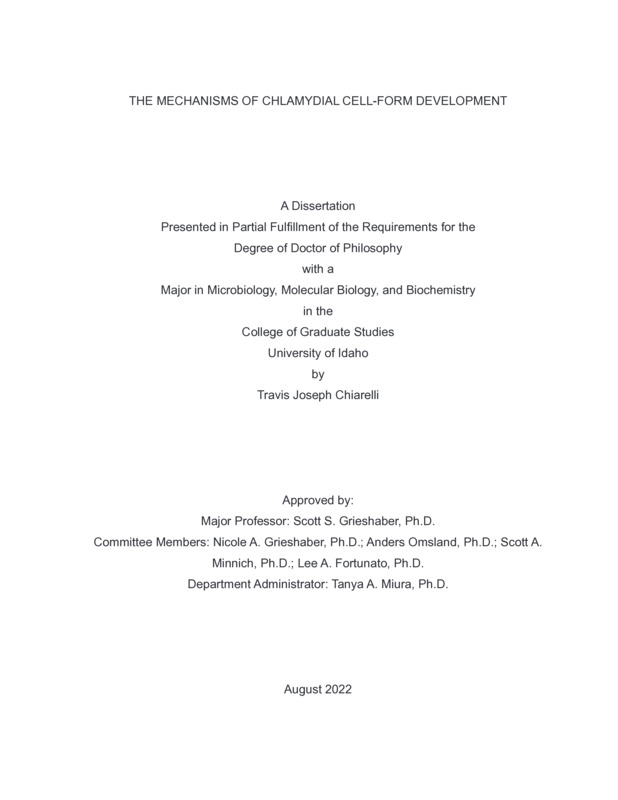The Mechanisms of Chlamydial Cell-form Development
Chiarelli, Travis Joseph. (2022-08). The Mechanisms of Chlamydial Cell-form Development. Theses and Dissertations Collection, University of Idaho Library Digital Collections. https://www.lib.uidaho.edu/digital/etd/items/chiarelli_idaho_0089e_12415.html
- Title:
- The Mechanisms of Chlamydial Cell-form Development
- Author:
- Chiarelli, Travis Joseph
- ORCID:
- 0000-0003-1378-9162
- Date:
- 2022-08
- Keywords:
- bacterial development chlamydia computational modeling infectious disease live-cell microscopy
- Program:
- Biological Sciences
- Subject Category:
- Microbiology; Molecular biology; Biochemistry
- Abstract:
-
Chlamydiae are obligate intracellular Gram-negative bacteria that infect an array of eukaryotic hosts. Chlamydia trachomatis, a human-adapted species, is the global leading cause of bacterial sexually transmitted infections as well as trachoma, a preventable form of blindness. All Chlamydiae progress through an essential biphasic developmental cycle consisting of two primary cell forms. The elementary body, or EB, is the infectious, non-replicating, cell form. Whereas, the reticulate body, or RB, is non-infectious, but replication competent. The infectious cycle is initiated by the EB via pathogen-mediated endocytosis. Once inside the host, development occurs within a parasitophorous vacuole, termed the inclusion. Within the first 11 hours of infection, the nascent inclusion migrates to the microtubules organization center and the EB undergoes primary differentiation into the replicating RB. At approximately 20 hours post infection, a subset of RBs begins secondary differentiation back into infectious EBs. Secondary differentiation continues through the remainder of the infectious cycle until host cell lysis or inclusion extrusion releases the EBs into the environment to initiate subsequent rounds of infection. Although the ability to transition from EB-to-RB-to-EB is essential for chlamydial growth and proliferation, the mechanisms that regulate Chlamydia cell-form development remain largely unknown. This dissertation demonstrates the power of combining automated live-cell microscopy and cell-form specific reporter strains to monitor chlamydial developmental dynamics in active infections. Computational models were developed to test multiple chlamydial developmental hypotheses, explore cell-form subpopulation dynamics, and guide in vivo experiments. The data from these experiments suggests that Chlamydia is not only responding to an intrinsic developmental signal, but that cell-form differentiation is a multi step process consisting of both cell division dependent (RB-to-IB asymmetric production) and independent (IB-to-EB direct maturation) mechanisms. Lastly, to elucidate the genes involved in RB-to-EB differentiation we developed a mutagenesis screen using automated live-cell microscopy and a dual cell-form specific chlamydial reporter strain.
- Description:
- doctoral, Ph.D., Biological Sciences -- University of Idaho - College of Graduate Studies, 2022-08
- Major Professor:
- Grieshaber, Scott S
- Committee:
- Grieshaber, Nicole A; Omsland, Anders; Minnich, Scott A; Fortunato, Lee A; Miura, Tanya A
- Defense Date:
- 2022-08
- Identifier:
- Chiarelli_idaho_0089E_12415
- Type:
- Text
- Format Original:
- Format:
- application/pdf
- Rights:
- In Copyright - Educational Use Permitted. For more information, please contact University of Idaho Library Special Collections and Archives Department at libspec@uidaho.edu.
- Standardized Rights:
- http://rightsstatements.org/vocab/InC-EDU/1.0/

